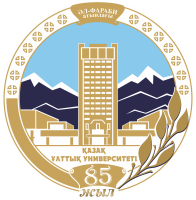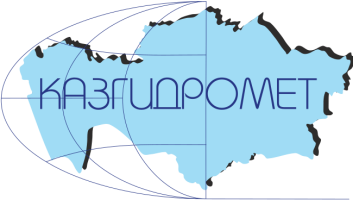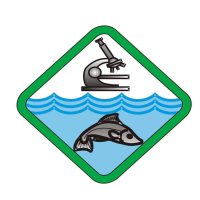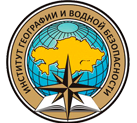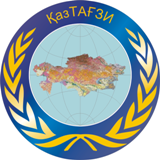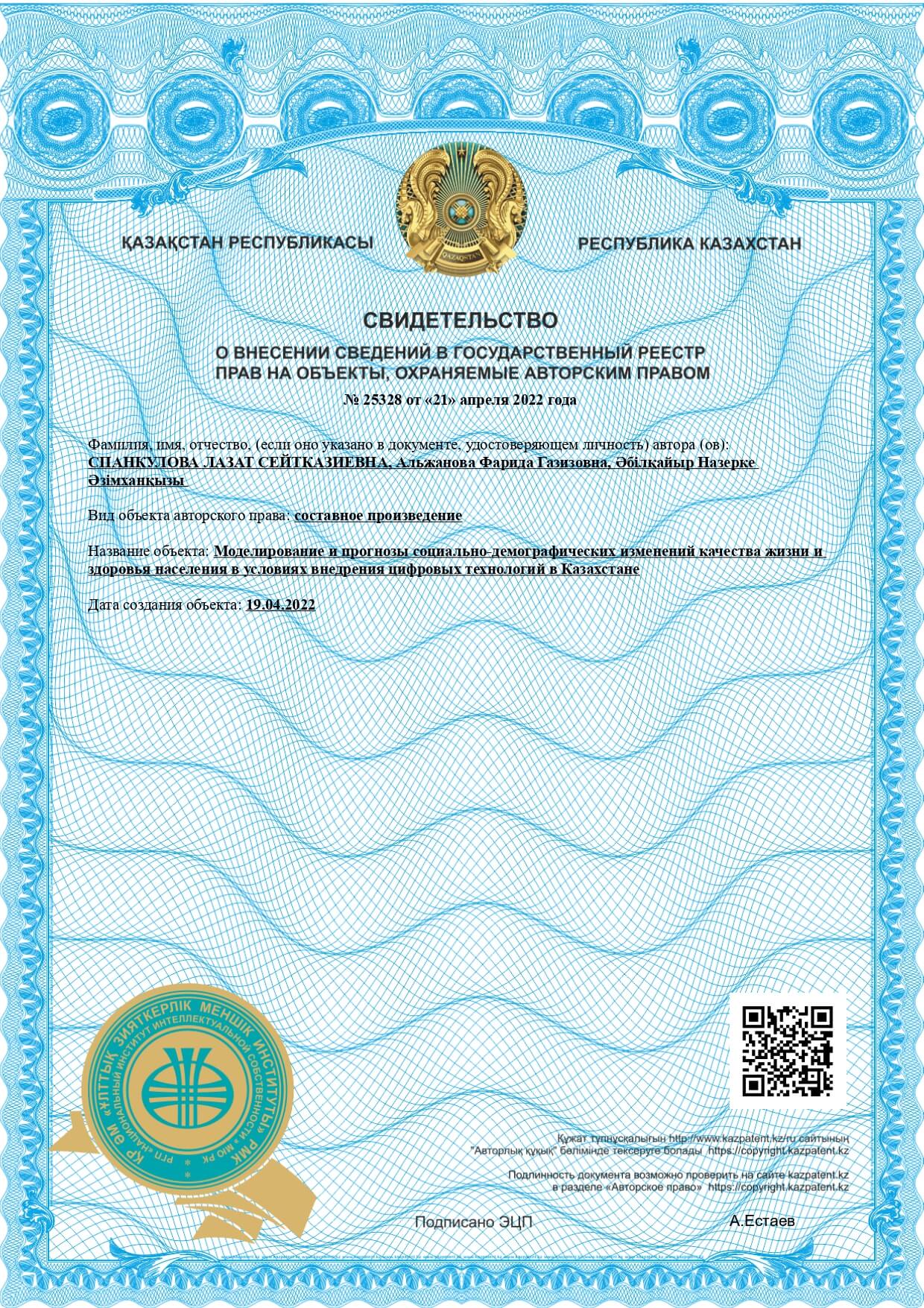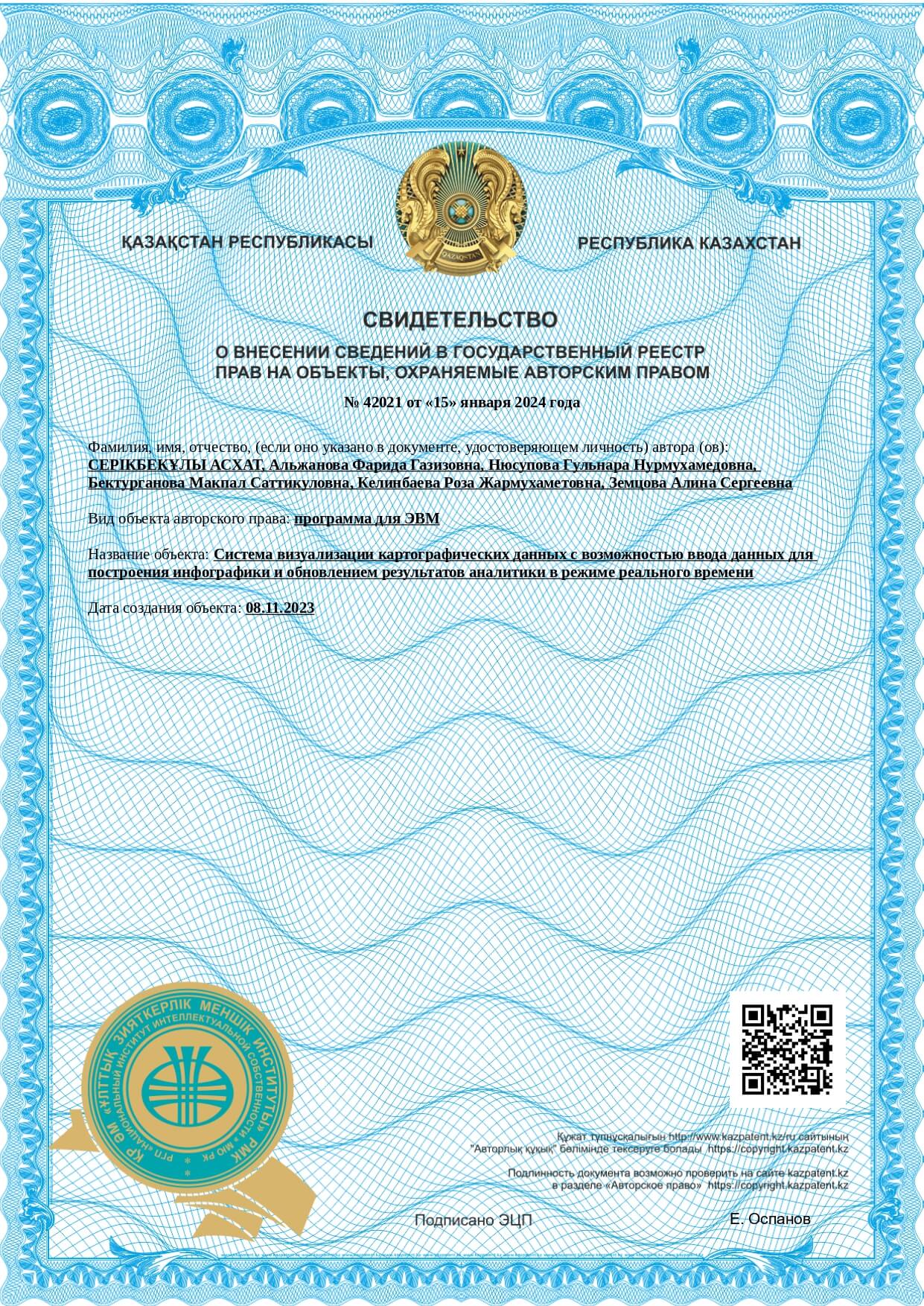Official website of the program: https://project.ieconom.kz/
(2021-2023 years)
IRN BR10965247
State registration number 0121РК00827
Program code Ф.1032
Decision of the National Scientific Council on the priority “7. Research in the field of social sciences and humanities “(No. 10 dated July 15-16, 2021).
The decision of the Higher Scientific and Technical Commission under the Government of the Republic of Kazakhstan (No. 2, dated August 10, 2021).
Contract No. 370 for program-targeted financing for 2021-2023 dated September 3, 2021 (Nur-Sultan).
The purpose of the program is multicenter research of the current demographic situation in Kazakhstan, forecast for its further development, and development of recommendations for the successful implementation of a long-term people-saving policy.
Objectives of research:
- Performance of a demographic audit of government programs, assessment of their impact on the intensity of demographic processes, risks, and implementation capabilities of demographic policy of Kazakhstan identification, development of recommendations for its improvement;
- Study of the political and legal framework to regulate demographic and migration processes in Kazakhstan and abroad, the development of effective measures to prevent the negative scenario, and more complete use of the positive one.
- Study of the demographic structure of the population and its changes, taking into account all demographic phenomena (birth rate, death rate, migration), determination of the scale and intensity of demographic processes within the country and region-wise.
- Study of the characteristics of the demographic system functioning under the influence of various factors (political and legal; political and economic; social and cultural; natural and environmental factors; historical and geographical factors; urbanization, COVID 19 pandemic).
- Making of mid-term and long-term forecasts for the demographic processes in Kazakhstan and region-wise development.
- Study of the structure, dynamics, quality of internal and external migration flows, the scale, social and political, social and cultural risks of migration, the impact of the COVID 19 pandemic on migration processes in Kazakhstan.
- The research of factors, rates, intensity, quality of urbanization and urban development in Kazakhstan, analysis of the main challenges and risks of urbanization, demographic and migration profile of cities in Kazakhstan, and the impact of the COVID-19 pandemic on urban development and the dynamics of urbanization.
- Study of possible conditions for the development of the demographic situation in the country in order to develop effective measures to prevent the consequences of the implementation of the negative and the fullest use of the potential of the positive scenarios
Development of scenarios for the development of the social, economic and political situation under the influence of the demographic factor in order to develop effective measures to prevent the consequences of the implementation of the negative and the fullest use of the potential of the positive forecast
STUDY OF FACTORS, CHARACTERISTICS AND DYNAMICS OF DEMOGRAPHIC PROCESSES, MIGRATION, URBANIZATION IN KAZAKHSTAN, DEVELOPMENT OF DIGITAL MAPS AND FORECASTS
(interim, stage 1)
2021 year
Study objective of the first stage (2021)– identify the main trends in demographic development over 30 years, develop forecasts for the population in Kazakhstan and its regions based on an analysis of the factors and dynamics of demographic processes, migration and urbanization, the political and legal framework intended to govern demographic processes in Kazakhstan.
Tasks of the first stage (2021):
- to analyze the population demographic structure, dynamics, demographic processes in Kazakhstan and its regions;
- to study the migration factors, the intensity and quality of internal and external migration flows in Kazakhstan, to analyze the legal, political, social and economic migration factors;
- to consider current trends in the development of urban systems, analyze the urbanization factors, intensity and quality in Kazakhstan;
- to study modeling and forecasting methods and algorithms for the demographic situation, to assess the impact of current population reproduction trends on the future size and composition of the population;
- to conduct a comparative analysis of the political and legal framework intended to govern demographic processes in Kazakhstan and abroad, systematize demographic parameters and compare them with the target parameters of demographic development programs in Kazakhstan.
- to collect material intended to create a demographic data database in the context of regions and cities of the Republic in Kazakhstan with the purpose to develop digital maps.
- to develop a layout, algorithm, program code, program web site.
Results of the first stage (2021):
- population reproduction trends in Kazakhstan and in its regions have been revealed; the intensity of demographic changes in the country and its regions has been determined based on the analysis of mortality and birth rates;
- the analysis of the settlement of ethnic groups and ethno-demographic processes in the regions and its impact on the demographic situation in the regions has been performed; the ethnic and internal migration trends of the urban and rural population and their impact on the prospects for demographic development have been identified;
- the birth decline factors in the order of birth of the first and second child and their influence on the expected demographic situation have been determined; the causal relationships of the birth dynamics in the future as the main factor to predict demographic processes have been revealed;
- an assessment of the current demographic situation in the regions has been given based on the comprehensive analysis performed with the construction of a diagram-map;
- the main trends in the development of external migration processes, incl. its dynamics, intensity and qualitative composition of migrants have been identified; the characteristic of internal migration flows in Kazakhstan, incl. their dynamics, structure, directions, causes and conditions have been given;
- the main socio-economic factors influencing the formation of internal and external migration flows have been identified; the main legal and political migration factors have been found;
- proposals have been made to form a national migration policy model based on the study of foreign experience in migration governance;
- it has been revealed that there has been a change in the role of individual cities, the fading of the role of cities in old industrial urbanized regions, the emergence of new leaders in the evolution course of the cities in Kazakhstan, it has been shown that the urban system in Kazakhstan is evolving towards a model characteristic of developing countries with a high concentration of population in the largest cities with an increase in the tendency for the reduction of the population density in medium and small towns;
- the factors of urbanization have been identified based on an interdisciplinary approach, the classification of the totality of urbanization factors (historical, demographic, geographical and territorial-spatial, economic, social, technical, environmental, natural and climatic, institutional and managerial, geopolitical, global) has been performed;
- three categories of regions with high and moderate rates of urbanization, as well as regions with characteristic deurbanization, have been identified based on the calculated urbanization intensity coefficients, trends in the growth of the urban population occurring due to an increase in the birth rate and migration, the orientation of migration flows to the country’s megacities have been identified;
- a comparative analysis of the political and legal framework intended to govern demographic processes in Kazakhstan and abroad have been performed, the main socio-economic factors influencing the formation of internal and external migration flows have been performed; the main legal and political migration factors have been performed; demographic parameters have been systematized, and compared with the target parameters of state programs that affect the natural reproduction process for the population in Kazakhstan.
- the collection and compilation of data in the form of MS Excel tables has been performed for the main sections of demographic statistics, thematic cartographic materials, topographic maps, schematic maps for the subsequent creation of vector thematic layers for the period of 1991-2020;
- a website for the program https://project.ieconom.kz has been developed, information about the program and its performers has been posted.
Degree of approbation and implementation. At the first stage (2021) from September to November 2021 6 articles were published in foreign scientific journals, including 1 article the Web of Science database (Core Collection – Emerging Sources Citation Index, IF 0.15, Q4), 3 articles in the international conference proceedings, the researchers had 9 speeches at conferences and round tables.
Execution period: August 10 – October 15, 2021. The report is presented in a brief version. The full version of the report contains 320 pages.
ABSTRACT
Report 171 pages, 1 book, 16 figures, 5 tables, 106 references, 9 annexes.
DEMOGRAPHY, POPULATION, PEOPLE SAVING, NATURAL POPULATION INCREASE, MIGRATION, LABOR MIGRATION, URBANIZATION, URBAN SYSTEM.
Object of the study is the population in the Republic in Kazakhstan.
Purpose of the study is a comprehensive study of the modern demographic situation in Kazakhstan, forecast for its further development, development of recommendations for the successful implementation of a long-term people-saving policy.
Research methods: methods of demographic analysis (method of cohorts, longitudinal and cross-sectional demographic analysis, methods of standardizing demographic coefficients, relative and average values, indices); panel data methodology, the method of correlation-regression analysis, methods intended to assess the absolute and relative migration parameters; forecasting methods (extrapolation method and cohort-component method), methods of political, legal and institutional analysis, methods of geoinformatics.
Main results and their novelty: analysis of the demographic structure of the population, dynamics, demographic processes in Kazakhstan and its regions has been performed; factors, types, intensity, quality of internal and external migration flows have been identified; analysis of legal, political, social and economic migration factors has been performed; the current trends in the urban system development in Kazakhstan have been identified, the factors of urbanization intensity and quality have been identified and analyzed; the modeling and forecasting methods and algorithms for the demographic situation have been substantiated, the influence of modern population reproduction trends on the future size and composition of the population have been revealed, a demographic forecast in Kazakhstan and the regions has been developed based on two methods; a comparative analysis of the political and legal framework intended to govern demographic processes has been performed, demographic parameters have been systematized and compared with the target parameters of demographic development programs in Kazakhstan; a demographic data database broken down by regions has been created, and a website for the program has been developed.
Efficiency: The knowledge gained will contribute to the development and adoption of measures by government bodies to use the demographic potential of the country and regions effectively, to govern migration flows, to mitigate the risks of demographic imbalances, to improve the standard and quality of life, education, health, employment growth, and the number and quality of jobs.
Scope of application: by state authorities to improve demographic and migration policies, to develop new program documents, strategic and current plans of ministries and departments, regional and city akimats, in the educational process and for further researches.
2022 year
The purpose of the study of the second stage (2022) is to identify the influence of a system of factors on demographic development, challenges, risks, consequences of migration and urbanization, to substantiate the parameters of the future demographic situation, the directions of adaptation of migration policy in order to strengthen the demographic potential of Kazakhstan.
The objectives of Stage 2 (2022)are:
- to consider the impact of political and legal; economic; socio-cultural; natural and ecological; historical and geographical factors; urbanization; COVID-19 pandemic on the demographic development of Kazakhstan.
- to assess the socio-political, socio-cultural risks of migration in Kazakhstan, to identify problems of integration and adaptation of migrants
- to analyze the challenges of urbanization in Kazakhstan, the impact of the COVID-19 pandemic on urban development, demographic and migration potential and profile of cities in Kazakhstan;
- to assess the parameters of the future demographic situation, to develop a demographic forecast taking into account the dynamics of the mortality rate, the gender and age structure of the population;
- to investigate institutional and legal measures aimed at regulating migration processes, to assess the achievability of target indicators, to identify and justify the tasks of migration policy in the context of demographic development of the Republic of Kazakhstan;
- create vector layers and a digital basis for thematic demographic maps.
- to update information, post information about research results, program activities, publications, implementations.
Results of 2nd stage (2022):
- it is shown that in the long-term historical process, demographic evolution and regional demographic structure in Kazakhstan are due to a combination of economic, political, socio-cultural factors that determined the transition from the traditional type of reproduction to the industrial one, a change in the role of education, the quality of medical care, the position of women in society, an increase in the number of small and medium-sized families, the peculiarities of the ethno-social structure of society, different contributions of large ethnic groups to the dynamics of population reproduction;
- the influence of socio-economic factors based on the relationship of fertility with GDP per capita, per capita nominal incomes and the proportion of the population with an income below the subsistence minimum in different time intervals is considered, different degrees of closeness between variables (positive, not observed, negative) in different historical periods are revealed;
- based on cluster analysis, regions were grouped by demographic potential based on the coefficients of total mortality, infant mortality, demographic burden, the proportion of children born fifth or more in order, clusters with high (1), stationary (2) and low (3) demographic potential were identified, it was shown that the slowdown in demographic growth occurs under under the influence of the third cluster, it is shown that there are no positive links between per capita income and demographic indicators in cluster groups;
- the role of socio-cultural factors is considered through the accessibility of education, it is shown that the specifics of the placement of vocational educational institutions determines the increasing difference and a twofold gap in the age groups of graduates of grades 9 and 11 in rural areas;
- the analysis of cause-and-effect relationships of the stability of demographic development on the basis of a normative dynamic model, which showed that the instability of fertility since 2015 is due to a decrease in the number of women of fertile age as a consequence of trends in the late 1990s and a decrease in the birth rate in the order of the first and second child, and to maintain a stable demographic reproduction, it is necessary to support large families (more than 4-5 children);
- based on the conducted expert survey on the problems of migration processes in Kazakhstan, an assessment of socio-political and socio-cultural risks of migration is given, the most important among which are identified marginalization, increased crime, social tension, lack of legal competence and rejection of the culture and traditions of the host country, interethnic, intergroup conflicts, lack of linguistic and communicative competencies;
- socio-economic risks of migration (labor, youth, rural) have been identified, a set of attracting and pushing factors for the population of Kazakhstan has been identified, with the identification of vulnerable points affecting the population’s relocation to other countries and regions; measures to improve the mechanisms for regulating migration flows have been proposed;
- the influence of living standards on migration processes has been studied, a comparative analysis of regions has been carried out by the proportion of workers with an average salary level not exceeding the socially necessary consumer budget, it is shown that in most regions of Kazakhstan the number of workers with a low average monthly salary (up to 150 thousand tenge before taxes) ranges from 52% to 74%;
- the main factors of successful adaptation of migrants are identified, and recommendations are given on the adaptation of internal migrants, primarily young people, and the integration of external migrants, taking into account the selected groups
- based on the results of the focus groups conducted in the North Kazakhstan region, the main problems of the implementation of the South-North program are identified, it is shown that resettlement programs will be ineffective until push factors prevail to a greater extent in the arrival regions, recommendations are given to improve the effectiveness of programs by combining tasks to preserve the local population and attract voluntary migrants, reduce hidden factors of social conflicts during the implementation of the program by introducing the principles of inclusive development;
- a multifactorial factor model of the relationship of migration processes with the level of nominal wages, unemployment, informal employment, living standards of the population, investments, cultural and educational environment has been developed;
- the analysis of the challenges of urbanization in the context of the concept of urban metabolism on the example of Astana, Almaty, revealed a positive correlation between energy consumption, emissions of pollutants and population, revealed a higher degree of dependence of electricity and heat consumption of Astana and atmospheric pollution in Almaty on population growth;
- the social consequences of the growth of three Kazakh megacities are considered, the dynamics and structure of employment, unemployment, per capita expenditures and income of landscaping, restrictions for growth in terms of demographic capacity of megacities by territory and water resources are analyzed, a correlation analysis of the relationship between the population and the crime rate, the number of self-employed, housing prices in Astana and Almaty is carried out;
- an assessment of the demographic consequences of the COVID-19 pandemic on the cities of Kazakhstan was carried out, which manifested themselves in a relative decrease in the rate of urbanization, a decrease in the birth rate in cities, high excess mortality among the urban population, an increase in maternal and perinatal mortality among the urban population, a change in the structure of causes of mortality during the pandemic;
- alternative methods of assessing the level of urbanization are considered, taking into account the actual population in settlements of different types, it is revealed that the potential of urbanization in Kazakhstan, taking them into account, has a higher level;
- an analysis of the profile of demographic stability and mobility of the urban population of the regions and 59 cities of Kazakhstan was carried out, a rating assessment of the demographic stability of the cities of Kazakhstan was given;
- alternative approaches to the classification of cities in Kazakhstan are proposed, taking into account the average low population density indicators, an assessment of the level of diversification and a comparative assessment of the vulnerability of the urban framework of the regions, including taking into account demographic stability on the example of the cities of Kostanay and North Kazakhstan regions;
- it is recommended that when developing programs for resettlement to labor-deficient regions, along with the formal status of the settlement, different criteria should be taken into account: number, natural growth, demographic stability, population density, diversification and vulnerability of the urban framework of the territory, ensuring ethno demographic balance, borderline.
- variants of population forecasts up to 2050 have been developed based on various forecast models: forecast based on the perspective method (27,469 thousand people) and forecast based on the method of movement (30,287 thousand people); forecast using the average growth coefficient (25,113 thousand people); forecast based on natural and mechanical movement (25,640 thousand people).); forecast based on a polynomial of the second degree (30,829 thousand people) and a polynomial of the third degree (44,797 thousand people);
- a forecast of demographic dynamics, the number and composition of the population up to 2100, changes in demographic indicators and demographic structure in the context of age groups has been developed, on the basis of which, among which the main trends are changes in life expectancy, fertility, mortality, the ratio of men and women, demographic loading and aging of the population;
- population forecast by regions of Kazakhstan up to 2050 by gender and age groups have been made;
- shortcomings of the institutional and legal framework for regulating migration processes in Kazakhstan, developed as part of the reform of the state planning system, inconsistency of the Migration Policy Concept with the requirements of regulatory methodological documents; inadequate use of methods of analysis of processes and phenomena in the field of migration regulation, have been identified.;
- based on the analysis of actual and projected migration indicators, the program documents assess the quality of the choice of indicators in terms of the full coverage of the tasks set for migration policy, the development of the methodology for their assessment, the achievability of target indicators, an expanded list of indicators is recommended.;
- the directions of migration policy that contribute to strengthening the demographic potential and human resources of Kazakhstan, including modernization and improvement of the quality of the institutional and legal framework containing parameters and tools for regulating migration processes, strengthening control over migration flows, countering the outflow of skilled labor and youth, attracting highly qualified foreign workers, recommended a list of target indicators that ensure compliance with the plans of national projects, development plans of central government agencies and regions.
- the analysis of the collected cartographic materials was carried out and the revision of cartographic vector data was carried out on the territory of the regions of the Republic of Kazakhstan, vector data (administrative-territorial units) were created on the territory of the Republic of Kazakhstan, on a geo information platform, based on topographic and other maps.
- information on research results, program activities, publications, and implementations has been posted. https://project.ieconom.kz/
Degree of approbation and implementation.
At the second stage (2022), including the period from November 15, 2021 to November 1, 2022, 41 articles were published, including: 4 articles in publications indexed in the Scopus, Web of Science citation databases, including 2 articles – Q2 (Social Sciences 90 percent, Demography 67 percent); 10 articles in editions recommended by Control Committee in Education and Science of the Republic of Kazakhstan; 5 articles in other foreign citation databases; 22 articles in materials of international and foreign conferences.
Copyright certificates:
– Certificate of entry of information into the State register of rights to objects protected by copyright composite work) / No. 25328 dated April 21, 2022 (Modeling and forecasts of socio-demographic changes in the quality of life and health of the population in the context of the introduction of digital technologies in Kazakhstan)
The report was made as part of an interdisciplinary group of researchers based on the staff of the Institute of Economics of the SC MSHE RK in the following composition.
Scientists of the Institute of Economics (Almaty, Astana branch), Al Farabi Kazakh National University (Almaty), Suleiman Demirel University (Kaskelen), Turan University (Astana, Almaty), KIMEP University (Almaty), Asfendiyarov Kazakh National Medical University (Almaty), Institute of Socio-Economic and Energy Problems of the North of Komi, NC Ural Branch RAS (Russia, Syktyvkar) took part in the research.
The inventory number of the interim Annual Report of the 1st stage (2021 y) is No.0221RK00573.
The preliminary report by 2022 year was discussed by Academic Council of the Institute of Economics (Protocol Solution No.3 of June 22, 2022). The annual report was reviewed and approved by the Academic Council of the Institute of Economics (Protocol Solution No.6 , October 6, 2022).
Research period: January 3 – October 30, 2022. The report is given in a brief version. The full version of the report is 480 pages.
ABSTRACT
Report 271 pages, 1 book, 14 figures, 25 tables, 103 references, 7 appendixes.
DEMOGRAPHY, POPULATION, MIGRATION, MIGRATION RISKS, STANDARD OF LIVING, EXCESS MORTALITY, DEMOGRAPHIC SUSTAINABILITY, PEOPLE SAVING MIGRATION POLICY, FORECAST, URBANIZATION, MEGAPOLIS.
Object of the study is the population in the Republic in Kazakhstan. The purpose of the study is to identify the influence of the system of factors on demographic development, migration and urbanization, to justify the parameters of the future demographic situation, the direction of adaptation of migration policy in the interests of strengthening the demographic potential of Kazakhstan.
Research methods: methods of demographic analysis; expert methods, the method of correlation-regression analysis, forecasting methods (cohort-component method), methods of political, legal and institutional analysis, methods of geoinformatics.
The main results and their novelty: An assessment of the influence of demographic development factors, cause-effect relations of the demographic stability of Kazakhstan were identified; assessment of socio-political and socio-cultural factors and risks of migration; recommendations for adaptation and integration of internal migrants and ethnic Kazakhs (қandas) have been developed; multifactorial model of migration processes has been developed; analysis of the challenges of urbanization, metabolism, social consequences of the growth of megacities, analysis of the demographic stability of cities; population forecast was developed by age groups across Kazakhstan (up to 2100) and by regions (up to 2050); shortcomings in the institutional and legal framework for regulating migration were identified as part of the reform of the state planning system; assessment of the achievability of the target indicators; directions of migration policy are defined.
Efficiency: the knowledge gained will contribute to the development of measures in the field of demographic, migration and urban planning policies, mechanisms for overcoming demographic, migration and urbanization challenges, ensuring conditions for demographic balance and sustainability of the regions of Kazakhstan.
Application field: by the state authorities in improving demographic and migration policies; in developing new program documents, strategic and current plans of ministries and departments; by regional and local administrations; for educational purpose and further research.
The main technical economic indicators: 4 articles SCOPUS (2 article – Q2 (Social Sciences 90 percent, Demography 67 percent); 10 articles in publications recommended by Control Committee in Education and Science of the Republic of Kazakhstan; 22 articles in materials of international and foreign conferences. Level of implementation: Copyright Certificates (21.04.2022 ж. № 25328).

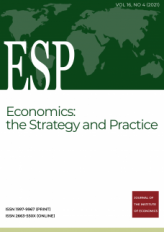


 High-tech economy: factors of formation, priorities and development mechanisms in Kazakhstan
High-tech economy: factors of formation, priorities and development mechanisms in Kazakhstan Diversification and growth of high-tech exports of Kazakhstan: mechanisms and priorities
Diversification and growth of high-tech exports of Kazakhstan: mechanisms and priorities Territorial localization of the knowledge-intensive sector of the economy of Kazakhstan: principles, potential and development scenarios
Territorial localization of the knowledge-intensive sector of the economy of Kazakhstan: principles, potential and development scenarios Human capital in the labor market in the context of technological modernization of Kazakhstan
Human capital in the labor market in the context of technological modernization of Kazakhstan Social innovations and quality of life of the population of Kazakhstan in the conditions of the information society
Social innovations and quality of life of the population of Kazakhstan in the conditions of the information society Model of the investment and financial system in the formation of a knowledge-based economy in Kazakhstan
Model of the investment and financial system in the formation of a knowledge-based economy in Kazakhstan Science in the digital environment: research practice models, network infrastructure and digital tools
Science in the digital environment: research practice models, network infrastructure and digital tools Intellectual support of a knowledge-based economy in Kazakhstan: potential, effects and prospects
Intellectual support of a knowledge-based economy in Kazakhstan: potential, effects and prospects


















